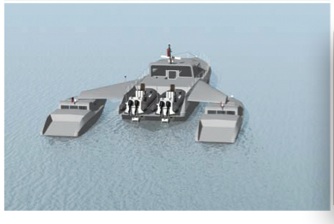Mission Configurable Modular Craft Concept Study
Keywords:
planing, high-speed craft, multi-hulls, seakeepingAbstract
This work illustrates how modern high speed craft design tools may be effectively used to evaluate innovative concepts for which empirical data may be limited. The example presented here was motivated by the US Navy’s interest in a finding a replacement for, or complement to, the USN Special Operations Forces’ Mark V high speed craft. Given the conflicting demands of restricted size and weight imposed by air transportability and broad mission requirements, a modular, multi-hull configuration is proposed and studied. The boat parameter space that influences calm water performance, sea keeping accelerations, and structural loads is explored. A proposed trimaran concept shows how intelligent placement of outer, or wing hulls can, in principle, mitigate shock loads and lower resistance, but with the cost of increased structural complexity and potentially a heavier craft.Downloads
References
AKERS, R.H., HOECKLEY, S.A., PETERSON, R.S., AND TROESCH, A.W. (1999) Predicted vs. Measured Vertical-Plane Dynamics of a Planing Boat. FAST 1999. Seattle, Washington, USA.
AMERICAN BUREAU OF SHIPPING (2001) Guide for Building and Classing: High Speed Craft. Houston.
ALLEN, R.G. AND JONES, R.R. (1977) Considerations on the Structural Design of High Performance Marine Vehicles. SNAME, New York and Metropolitan Section Meeting, January 13.
BLOUNT, D.L. AND HANKLEY, D.W. (1976) Full Scale Trials and Analysis of High Performance Planing Craft Data. Transactions, SNAME, Vol. 84.
CLARK, V. (2002) SeaPower 21 Series Part I: Projecting decisive joint capabilities. Naval Institute Proceedings, October.
COOPER, S. AND NORTON, M. (2002) New paradigms in boat design: An exploration into unmanned surface vehicles. Association for Unmanned Vehicle Systems International Symposium.
FRIDSMA, G. (1971) A Systematic Study of Rough-Water Performance of Planing Hulls (Irregular Waves - Part II), Stevens Institute of Technology, March.
GALE, P.A. (2003) The Ship Design Process. Chapter 5, Ship Design and Construction. The Society of Naval Architects and Marine Engineers (SNAME), Jersey City, New Jersey, pp. 5-1 to 5-40.
HELLER, S.R. AND JASPER, N.H. (1960) On the Structural Design of Planing Craft. Quarterly Transactions, RINA. July.
HUGHES, O.F. (1988) Ship Structural Design: A Rationally-Based, Computer-Aided, Optimization Approach. SNAME, Jersey City.
SAVANDER, B.R. (1997) Planing Hull Steady Hydrodynamics. Ph.D. Thesis, Department of Naval Architecture and Marine Engineering, The University of Michigan.
SAVANDER, B.R., SCORPIO, S.M., AND TAYLOR, R.K. (2002) Steady Hydrodynamic Analysis of Planing Surfaces. SNAME, Journal of Ship Research, Vol. 46, No. 4.
SAVITSKY, D. AND BROWN, P.W. (1976) Procedures for Hydrodynamic Evaluation of Planing Hulls in Smooth and Rough Water. Marine Technology, SNAME, October 1976.
SOKOL, W. AND HANSEN, E. (2001) Unmanned vehicles: A technology whose time has come. July 2001 Excerpt. www.dt.navy.mil.
SPENCER, J.S. (1975) Sructural Design of Aluminum Crewboats. Marine Technology, SNAME, New York, July.
TULIN, M. P. (1957) The theory of slender planing surfaces at high speed. Schiffstechnik, 4, 1225-133.
VORUS, W.S. (1996) A flat cylinder impact theory for analysis of vessel impact loading and steady planing resistance. Journal of Ship Research, Vol. 40, No. 2, pp. 89-106.
WAGNER, H. (1932) Uber stross-und gleitvorgange an der oberflache von flussigkeiten. ZAMM, 12 pp. 193-215.
ZARNICK, E.E. (1978) A Nonlinear Mathematical Model of Motions of a Planing Boat in Regular Waves. David W. Taylor Naval Ship Research and Development Center. Report Number DTNSRDC-78/032.
ZARNICK, E.E. (1979) A Nonlinear Mathematical Model of Motions of a Planing Boat in Irregular Waves. David W. Taylor Naval Ship Research and Development Center. Report Number DTNSRDC/SPD-0867-01.

How to Cite
Issue
Section
License
The authors who publish in this Journal certify that:
- The work submitted for publication in The Ship Science and Technology journal, was written by the author, given that its content is the product of his/her direct intellectual contribution.
- All data and references to material already published are duly identified with their respective credits and are included in the bibliographic notes and quotations highlighted as such.
- All materials submitted for publication are completely free of copyrights; consequently, the author accepts responsibility for any lawsuit or claim related with Intellectual Property Rights thereof, Exonerating of responsibility to The Science and Technology for the Development of Naval, Maritime, and Riverine Industry Corporation, COTECMAR.
- In the event that the article is chosen for publication by The Ship Science and Technology journal, the author state that he/she totally transfers reproduction rights of such to The Science and Technology for the Development of Naval, Maritime, and Riverine Industry Corporation, COTECMAR.
- The authors retain the copyright and transfer to COTECMAR the right of publication and reproduction of the work which will be simultaneously subject to the Creative Commons Attribution License (CC -BY) , which allows the license to copy, distribute, display and represent the work and to make derivative works as long as it recognizes and cites the work in the manner specified by the author or licensor.
- For more information about the Creative Commons Attribution License (CC -BY) and his use and scope, please visit the following web page https://creativecommons.org/licenses/by-sa/4.0/legalcode








